Perpetual Bundle
Unlocking the Secrets of Perpetual Company's Success?
Perpetual Limited, an Australian financial services giant with over 135 years of experience, stands as a testament to enduring success. Managing approximately A$230.2 billion in assets as of December 31, 2024, it offers a diverse range of services, including investment and wealth management. But how does this Perpetual SWOT Analysis help them thrive and maintain its ongoing business model in a constantly evolving financial landscape?
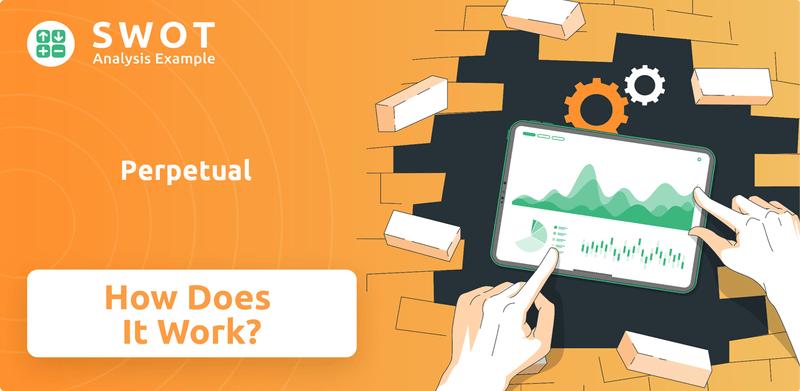
Understanding the Perpetual company's business model is key for investors and anyone interested in the company structure and business operations. This exploration delves into the mechanisms behind its enduring prosperity, highlighting how it generates revenue and navigates challenges. Discover the advantages of this everlasting enterprise and gain insights into its strategic direction.
What Are the Key Operations Driving Perpetual’s Success?
The core operations of a Perpetual company are structured around three main divisions: Perpetual Asset Management, Perpetual Wealth Management, and Perpetual Corporate Trust. These divisions work in concert to deliver a range of financial services, from investment management to corporate trust services, catering to a diverse clientele including institutional investors, high-net-worth individuals, and corporations. This integrated approach allows the ongoing business to offer comprehensive financial solutions.
The Perpetual company's value proposition centers on providing expert financial services and building long-term relationships with clients. The company aims to deliver superior investment performance, personalized financial advice, and robust corporate trust solutions. A key element of its strategy is to maintain a strong brand reputation and adapt to evolving market dynamics to ensure its everlasting enterprise.
The acquisition of Pendal Group Limited in January 2023 expanded the company's global multi-boutique asset management capabilities, enhancing its scale and distribution footprint.
Perpetual Asset Management provides specialist investment capabilities. It offers a range of investment strategies, including global value investing and ESG investing. As of December 31, 2024, 65% of its strategies outperformed their benchmark over three years.
Perpetual Wealth Management offers investment management, superannuation, and financial advice. It caters to retail, wholesale, and institutional markets. Services include financial planning, estate planning, and tax services.
Perpetual Corporate Trust offers fiduciary, agency, and advisory services. It supports financial institutions, government bodies, and not-for-profits. The division leverages digital solutions, such as Perpetual Digital, for enhanced efficiency.
Asset Management focuses on portfolio management and strategic planning. Wealth Management prioritizes client service and attracting top talent. Corporate Trust uses digital solutions to improve efficiency and compliance.
A key strength of the Perpetual company is its long-standing client relationships, some spanning five generations. The strong brand reputation contributes to its competitive edge, particularly in its Corporate Trust business. The company's ability to adapt and innovate is crucial for its long-term sustainability.
- The company's business model is designed for long-term value creation.
- The company structure supports diverse financial services.
- Ongoing investment in technology and talent enhances business operations.
- The focus on client relationships and reputation helps the everlasting enterprise.
Perpetual SWOT Analysis
- Complete SWOT Breakdown
- Fully Customizable
- Editable in Excel & Word
- Professional Formatting
- Investor-Ready Format
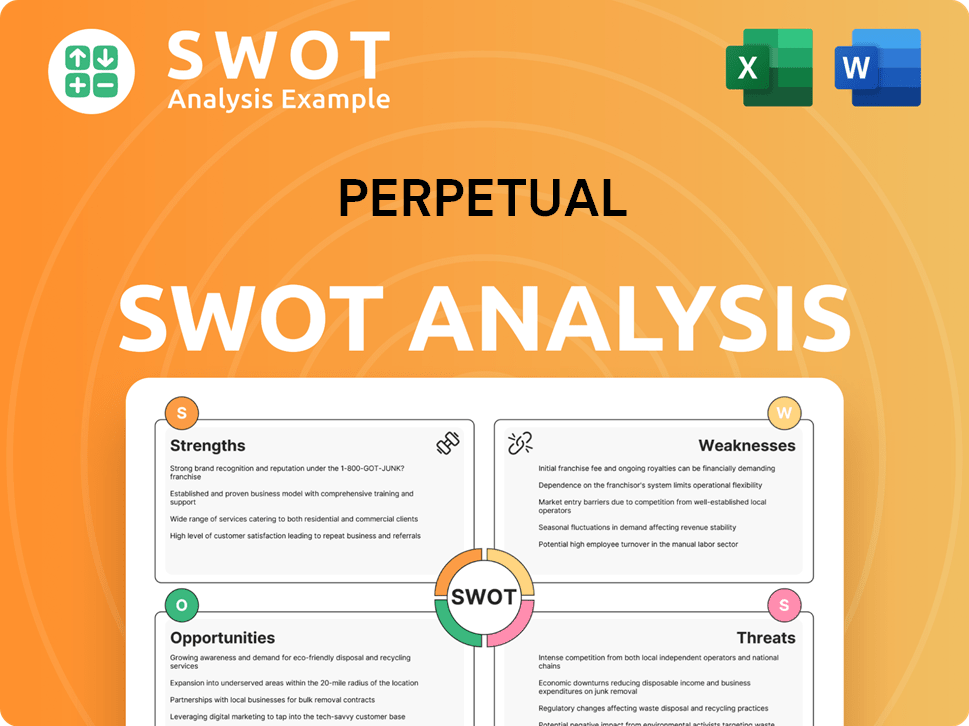
How Does Perpetual Make Money?
The Growth Strategy of Perpetual relies heavily on its revenue streams and monetization strategies. This ongoing business model focuses on generating income through fees tied to assets under management (AUM), funds under advice (FUA), and funds under administration (FUA).
This approach provides the everlasting enterprise with recurring revenue, directly influenced by the performance and value of the assets it manages. The company's financial performance in the first half of FY25 demonstrates the effectiveness of these strategies.
In the first half of FY25 (ended December 31, 2024), Perpetual reported an underlying profit after tax (UPAT) of A$100.5 million, a 2% increase from the prior corresponding period.
The Perpetual company's revenue streams are diversified across three main segments: Asset Management, Wealth Management, and Corporate Trust. Each segment contributes differently to the overall revenue and profitability, as detailed below:
- Asset Management: Generated A$455.0 million in revenue, up 4% on 1H24, with its underlying profit before tax (UPBT) at A$102.6 million, up 7% on 1H24. As of December 31, 2024, Asset Management's total AUM was A$230.2 billion.
- Wealth Management: Reported UPBT of A$29.2 million, a 12% increase on 1H24, with Funds Under Advice (FUA) at A$20.6 billion as of December 31, 2024, up 8% on 1H24. This growth was driven by non-market revenues and improved equity markets. Perpetual Private, the wealth management arm, committed AUD 60 million to Osmosis' flagship Responsible Investment strategy in March 2025.
- Corporate Trust: Delivered UPBT of A$44.0 million, an 8% increase on the prior corresponding period. Its Funds Under Administration (FUA) reached A$1.25 trillion as of December 31, 2024, up 4% on 1H24. The Debt Market Services division's FUA was A$725.2 billion, and the Managed Funds Services division's FUA was A$525.0 billion as of December 31, 2024.
Perpetual PESTLE Analysis
- Covers All 6 PESTLE Categories
- No Research Needed – Save Hours of Work
- Built by Experts, Trusted by Consultants
- Instant Download, Ready to Use
- 100% Editable, Fully Customizable
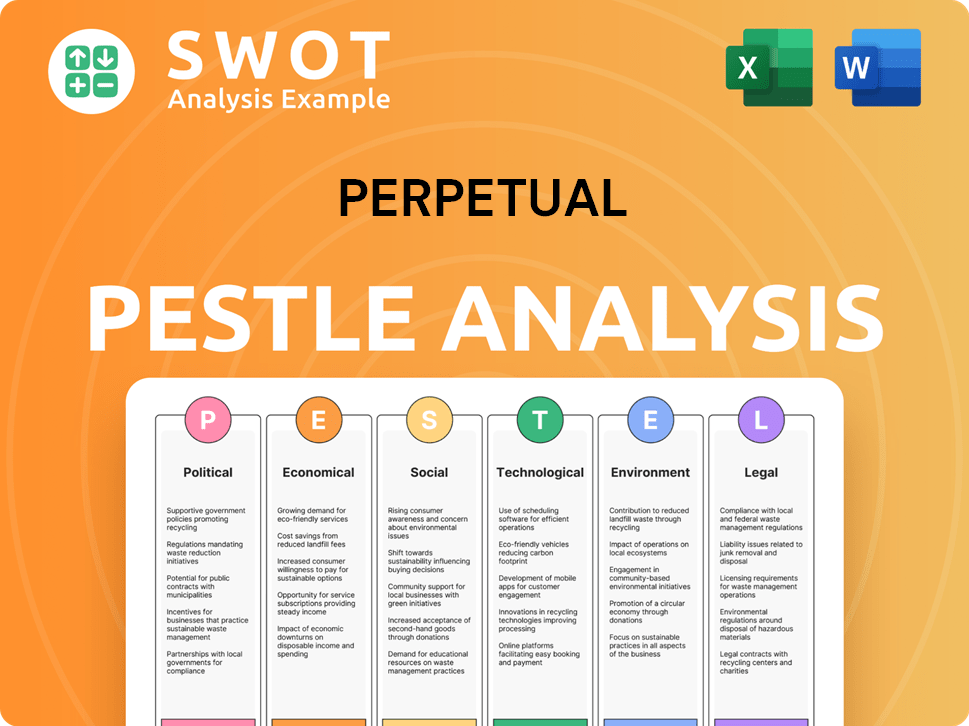
Which Strategic Decisions Have Shaped Perpetual’s Business Model?
The Growth Strategy of Perpetual has been marked by significant strategic moves and milestones. A key event was the acquisition of Pendal Group Limited, finalized in January 2023, which created a global leader in multi-boutique asset management. This strategic move aimed to strengthen Perpetual's position in the asset management industry.
In May 2024, Perpetual announced a proposed sale of its Wealth Management and Corporate Trust businesses to KKR for A$2.175 billion, a move designed to streamline the company into a standalone global multi-boutique asset management business. However, as of February 2025, discussions with KKR were terminated. This decision reflects the dynamic nature of the Perpetual company and its ongoing evaluation of its business model.
Despite operational challenges, including net outflows in some Asset Management strategies, Perpetual is focused on adapting to market trends and ensuring its long-term sustainability. The company's simplification program aims to deliver substantial cost reductions, enhancing its business operations and financial performance.
The acquisition of Pendal Group Limited in January 2023 was a major milestone, consolidating its position in the asset management sector. The proposed sale of Wealth Management and Corporate Trust businesses to KKR, announced in May 2024, aimed at streamlining operations, but discussions were terminated in February 2025. These moves highlight the everlasting enterprise's strategic agility.
Perpetual's strategic moves include the Pendal acquisition to expand its asset management capabilities. The proposed sale to KKR, although not finalized, demonstrated efforts to optimize its company structure. The simplification program, with a target of A$70 million to A$80 million in annualised cost reductions before tax by FY27, is a key strategic initiative.
Perpetual's competitive advantages include its strong brand strength, built over 135 years, and its position as a trusted advisor. The Corporate Trust business benefits from a wide moat due to its scale and cost advantages. The company's focus on ESG investing and debt reduction also enhances its competitive position.
In 1H25, J O Hambro experienced A$3.6 billion in net outflows. The simplification program achieved approximately A$10 million in annualised cost reductions in 1H25. Perpetual refinanced its syndicated debt facilities, expecting gross debt to be between A$740 million to A$750 million by June 30, 2025.
Perpetual's business model is characterized by its multi-boutique asset management approach and its Corporate Trust business. The company emphasizes its strong brand, long-standing reputation, and focus on ESG investing. These features contribute to its long-term sustainability and competitive advantage.
- Strong brand recognition and trust.
- Focus on ESG investing through Trillium Asset Management.
- Strategic acquisitions and divestitures to optimize operations.
- Commitment to cost reduction and debt management.
Perpetual Business Model Canvas
- Complete 9-Block Business Model Canvas
- Effortlessly Communicate Your Business Strategy
- Investor-Ready BMC Format
- 100% Editable and Customizable
- Clear and Structured Layout
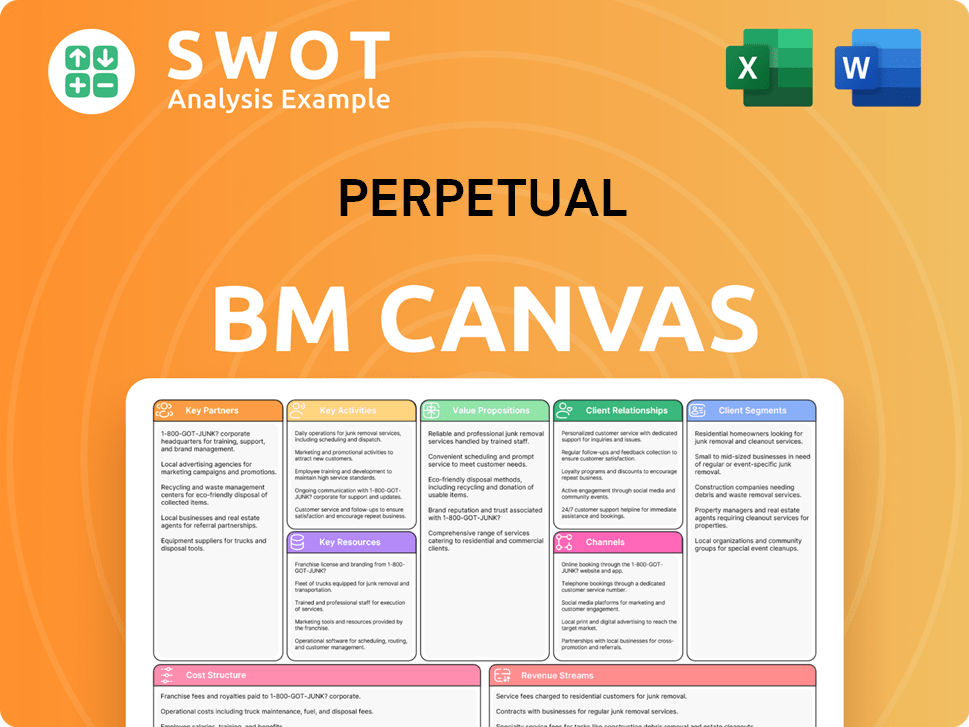
How Is Perpetual Positioning Itself for Continued Success?
The Australian financial services industry includes Perpetual Limited, a significant player listed on the S&P/ASX 200. The company operates within the Financials sector, alongside major banks. Perpetual's Corporate Trust business holds a strong position, especially in the Australian market. However, its asset management arm has faced challenges, including net outflows and a 'No Moat' rating from Morningstar Australia in April 2025.
Despite brand recognition and product diversity, the asset management segment of the Perpetual company experienced headwinds. In the year leading up to December 2024, most of its asset management brands, excluding Pendal and Perpetual Asset Management, saw net outflows. Also, only 63% of its strategies outperformed their benchmarks by the end of 2024, a decrease from 89% in 2022.
Regulatory changes, new competitors, and technological disruptions are key risks. The ongoing business is also affected by market fluctuations, margin changes, and client flows. Geopolitical risks and market valuations also present challenges.
Initiatives include simplifying the Asset Management business and achieving cost reductions. The company focuses on debt reduction, targeting A$740 million to A$750 million by June 30, 2025, and maintaining profitability through diversified earnings.
The outlook emphasizes active management, downside protection, and income stability. The goal is to navigate a potentially low-return environment and optimize income from various sources. The company aims to sustain and expand its profitability through diversified earnings and cost discipline.
Perpetual company is targeting A$70 million to A$80 million in annualised cost reductions by FY27 through its simplification program. The company's focus on debt reduction aims to reach a gross debt of A$740 million to A$750 million by June 30, 2025.
The everlasting enterprise aims to strengthen its position through strategic initiatives and financial discipline. The company is focused on adapting to market changes and maintaining profitability in a dynamic environment.
- Simplifying Asset Management operations.
- Achieving significant cost reductions.
- Reducing debt and optimizing income streams.
- Investing in core businesses.
Perpetual Porter's Five Forces Analysis
- Covers All 5 Competitive Forces in Detail
- Structured for Consultants, Students, and Founders
- 100% Editable in Microsoft Word & Excel
- Instant Digital Download – Use Immediately
- Compatible with Mac & PC – Fully Unlocked
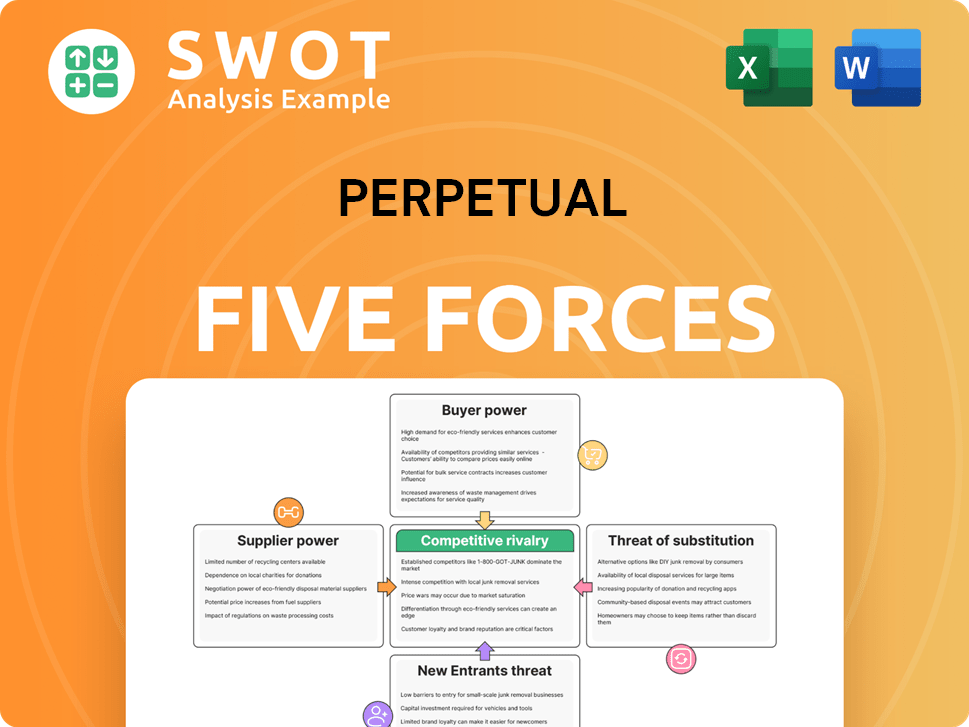
Related Blogs
- What are Mission Vision & Core Values of Perpetual Company?
- What is Competitive Landscape of Perpetual Company?
- What is Growth Strategy and Future Prospects of Perpetual Company?
- What is Sales and Marketing Strategy of Perpetual Company?
- What is Brief History of Perpetual Company?
- Who Owns Perpetual Company?
- What is Customer Demographics and Target Market of Perpetual Company?
Disclaimer
All information, articles, and product details provided on this website are for general informational and educational purposes only. We do not claim any ownership over, nor do we intend to infringe upon, any trademarks, copyrights, logos, brand names, or other intellectual property mentioned or depicted on this site. Such intellectual property remains the property of its respective owners, and any references here are made solely for identification or informational purposes, without implying any affiliation, endorsement, or partnership.
We make no representations or warranties, express or implied, regarding the accuracy, completeness, or suitability of any content or products presented. Nothing on this website should be construed as legal, tax, investment, financial, medical, or other professional advice. In addition, no part of this site—including articles or product references—constitutes a solicitation, recommendation, endorsement, advertisement, or offer to buy or sell any securities, franchises, or other financial instruments, particularly in jurisdictions where such activity would be unlawful.
All content is of a general nature and may not address the specific circumstances of any individual or entity. It is not a substitute for professional advice or services. Any actions you take based on the information provided here are strictly at your own risk. You accept full responsibility for any decisions or outcomes arising from your use of this website and agree to release us from any liability in connection with your use of, or reliance upon, the content or products found herein.